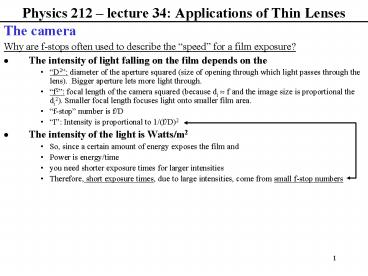Physics 212 lecture 34: Applications of Thin Lenses - PowerPoint PPT Presentation
1 / 4
Title:
Physics 212 lecture 34: Applications of Thin Lenses
Description:
Physics 212 lecture 34: Applications of Thin Lenses. The camera ... 'f2': focal length of the camera squared (because di f and the image size is ... – PowerPoint PPT presentation
Number of Views:224
Avg rating:3.0/5.0
Title: Physics 212 lecture 34: Applications of Thin Lenses
1
Physics 212 lecture 34 Applications of Thin
Lenses
- The camera
- Why are f-stops often used to describe the
speed for a film exposure? - The intensity of light falling on the
film depends on the - D2 diameter of the aperture squared (size of
opening through which light passes through the
lens). Bigger aperture lets more light through. - f2 focal length of the camera squared (because
di ? f and the image size is proportional the
di2). Smaller focal length focuses light onto
smaller film area. - f-stop number is f/D
- I Intensity is proportional to 1/(f/D)2
- The intensity of the light is Watts/m2
- So, since a certain amount of energy exposes the
film and - Power is energy/time
- you need shorter exposure times for larger
intensities - Therefore, short exposure times, due to large
intensities, come from small f-stop numbers
2
- The eye (and glasses)
- How do you correct near and far-sighted vision?
- Near Sightedness
- Occurs when the lens focuses the image in front
of the retina. Light needs to be spread out more
to correct this, and a diverging lens is used. - Far Sightedness
- Occurs when the lens focuses the image behind the
retina. Light needs to be brought together
earlier, and a converging lens is used.
3
- The magnifying glass
- Why do you place a magnifying glass close to the
object, not your eye? - A larger image is the desired result, so the
image must be magnified. - A virtual image is the type of image needed since
we are not using a screen. - Magnifying glasses are converging, which brings
light together. - Therefore, if the object is placed
- inside the focal length (near the glass), an
enlarged virtual upright image is formed - outside the focal length (near the eye), a
reduced real inverted image is formed
4
- The microscope
- Can you see atoms with a really powerful optical
microscope? - No.
- The wavelength of visible light (400-700nm) is
much larger than that of the atom, so we cannot
see them with a regular microscope no matter how
powerful it is.
- The telescope
- Why do some telescopes use mirrors while others
use lenses? - Cost (mainly).
- Small telescopes using lenses are cheaper to
produce than they are using mirrors. However, at
large sizes mirrors become more cost effective to
produce.































